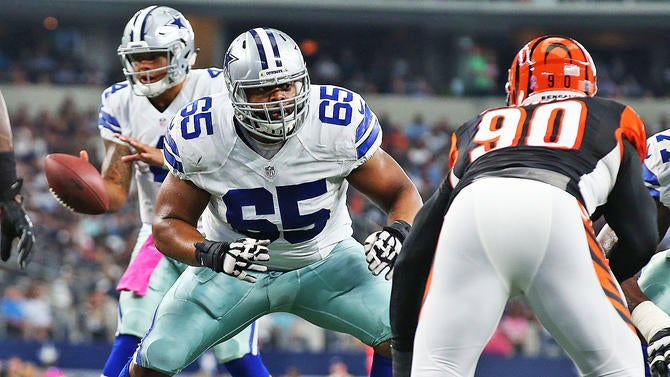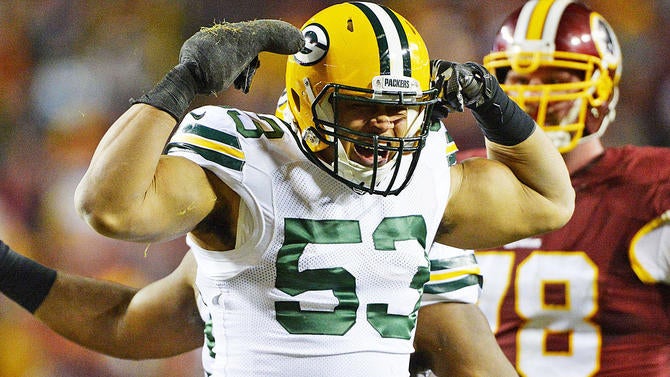Money came fast and furious for players once the free-agent signing period began March 9. The deals usually arenât what they appear to be because fully guaranteed contracts donât exist in the NFL, except for the first 20 picks in the NFL Draft. The lack of guarantees makes a contractâs structure of the utmost importance and gives teams an out for many of the most lucrative multiyear deals after just two years.
The predominant structure utilized by a majority of teams is a contract consisting of a signing bonus and salary guarantees. The base salary in the first contract year is usually fully guaranteed (injury, salary cap and skill guarantees) at signing. Roster bonuses in the first contract year that are due a few days after signing are fairly common. Even though these roster bonuses technically arenât guaranteed, they are considered part of the guaranteed money. Salary guarantees in subsequent contract years are mainly base salary. The trend is for base salaries after the second contract year to be conditionally guaranteed in the bigger deals. They are guaranteed for injury only initially but fully guaranteed if a player is on the teamâs roster on a specified date in each specific contract year. This date will vary from team to team but is normally within the first few days of the current league year.
Average salary and total compensation are the most common contract metrics but they are misleading because of the lack of security with NFL contracts. When assessing contracts, the more important metrics are compensation in the first three years of a multiyear deal and the amount of money fully guaranteed at signing or the amount of money that will become fully guaranteed early in the contract.
Hereâs a look at the key metrics for each teamâs most lucrative deals signed this offseason by players whose contracts were set to expire after the 2016 season. Thereâs a focus on the earliest realistic contract exit point for the team.
 Arizona Cardinals
Arizona Cardinals
Contract value: $82.5 million/5 years ($16.5 million average)
Contract guarantees: $53 million ($15 million as signing bonus)
Fully guaranteed at signing: $31 million
Three-year cash flow: $51 million
Earliest realistic exit point: 2020 ($51 million earned)
Jones got his deal extremely fast for a player receiving a franchise designation. The typical timing for such deals getting done is right before the annual July 15 deadline for franchise players to sign multiyear contracts.
Jones didnât quite fare as well as Oliver Vernon did last year as an unrestricted free agent despite being more consistent. Vernon received a five-year, $85 million contract containing $52.5 million in guarantees from the Giants, with $40 million of Vernonâs money fully guaranteed at signing and $54 million guaranteed over the first three years.
A big difference between Jones and Vernon is the vesting of the third-year salary. These base salaries, except $750,000 for Vernon, are guaranteed for injury at signing. $11.5 million of Jonesâ 2019 base salary is fully guaranteed on the third day of the 2018 league year (next March) and the remaining $5 million on the third day of the 2019 league year (March 2019). $12 million of Vernonâs $12.75 million third-year salary in 2018 doesnât become fully guaranteed until the exact same time as Jonesâ $11.5 million in March 2018.

 Atlanta Falcons
Atlanta Falcons
Atlantaâs major moves came before the end of the 2016 regular season by securing extensions with cornerback Robert Alford and right tackle Ryan Schraeder. Alfordâs December extension for $38 million over four years with $21 million in guarantees set the market for No. 2 cornerbacks. Schraeder received a five-year, $31.5 million extension (worth up to $33 million through salary escalators) containing $12.5 million in guarantees right around Thanksgiving.
 Baltimore Ravens
Baltimore Ravens
Contract value: $52.5 million/5 years ($10.5 million average)
Contract guarantees: $27.5 million ($12 million as signing bonus)
Fully guaranteed at signing: $24.5 million
Three-year cash flow: $33.75 million
Earliest realistic exit point: 2019 ($24.5 million earned)
Williams exceeding the five-year, $46.25 million deal that Damon Harrison got from the Giants as a free agent last March wasnât that surprising -- given the three-year extension Michael Brockers received early last season from the Rams. Brockersâ deal averages $11,083,333 with slightly more than $24 million in guarantees.
Williamsâ first two years are guaranteed at signing. A total of $3 million of his 2019 base salary, which is guaranteed for injury now, doesnât become fully guaranteed until the fifth day of the 2019 league year when his salary cap number is $11.75 million. The deal is worth a maximum of $53.75 million thanks to a $250,000 incentive for making the Pro Bowl.
 Buffalo Bills
Buffalo Bills
The biggest contractual development is quarterback Tyrod Taylor reworking his contract before Buffalo had a make a decision about picking up the option on his contract. Taylorâs contract would have been for an additional five years at $82.5 million (worth up to $101.75 million through salary escalators and incentives) running through the 2021 season. He would have received a $15.5 million bonus and a fully guaranteed $12 million base salary in 2017. Itâs now a two-year deal worth $30.5 million where $16 million is fully guaranteed. Taylor was scheduled to make $40.5 million through 2018 if the option had been picked up. Since there are three dummy years (2019-21) that automatically void five days after Super Bowl LIII in early February 2019, the Bills will be left with $5.56 million of dead money (a salary cap charge for a player no longer on the roster) because of signing bonus proration in those years.

 Carolina Panthers
Carolina Panthers
Contract value: $55.5 million/5 years ($11.1 million average)
Contract guarantees: $25 million ($12 million as signing bonus)
Fully guaranteed at signing: $13 million
Three-year cash flow: $33 million
Earliest realistic exit point: 2020 ($33 million earned)
Kalilâs deal was unexpected considering he missed most of the 2016 season because of a hip problem and has regressed since being named a Pro Bowl alternate as a rookie in 2012. The Panthers used the same signing and option bonus structure for Kalil that they used for the contracts of Cam Newton and Luke Kuechly. Carolina has a five-day window from the first to fifth days of the 2018 league year to exercise an option on Kalilâs 2021 contract year, which requires a $10 million payment. If the Panthers pass on Kalilâs 2021 contact year, he will still be owed the $10 million, provided he is on their roster on the sixth day of the league year.
Since an option bonus is given the same treatment on the salary cap as a signing bonus, this $10 million is also prorated on the salary cap at $2.5 million in 2018-21. Itâs conceivable that the Panthers could part ways with Kalil before the $10 million payment is due, giving him a one-year contract for $13 million with a terrible 2017 season despite a $9.6 million cap charge associated with his $12 million signing bonus. If Kalil can get past the first year, he should see at least three years of the deal because of excess bonus proration in releasing him.
 Chicago Bears
Chicago Bears
Contract value: $45 million/3 years ($15 million average)
Contract guarantees: $18.5 million ($3 million as signing bonus)
Fully guaranteed at signing: $18.5 million
Earliest realistic exit point: 2018 ($18.5 million earned)
The view of Glennonâs contract is matter of perspective. Giving $16 million in 2017 to a player that only threw 11 passes after the Buccaneers took Jameis Winston with the first overall pick in the 2015 draft might seem a bit pricey. At least the Bears didnât make the same mistake that the Texans did with Brock Osweiler, another unproven quarterback commodity, by fully guaranteeing Glennonâs second year worth $15 million. If Glennon is no better than Osweiler was for Houston last season, it wonât cost the Bears that much because his $2.5 million 2018 roster bonus, due the third day of the league year, is the only money guaranteed after this year.

 Cincinnati Bengals
Cincinnati Bengals
Contract value: $52.5 million/5 years ($10.5 million average)
Contract guarantees: $12 million ($7 million as signing bonus)
Fully guaranteed at signing: $12 million
Three-year cash flow: $32.8 million
Earliest realistic exit point: 2018 ($15 million earned)
The Bengals couldnât afford to lose Kirkpatrick with left tackle Andrew Whitworth and right guard Kevin Zeitler signing elsewhere. Kirkpatrick has a customary Cincinnati deal: His $7 million signing bonus and $5 million roster bonus, which was due March 13, is the only guaranteed money. His $3 million roster bonus, due on the fifth day of the 2018 league year, is supposed to be a substitute for additional contract guarantees. Despite the lack of guarantees, Cincinnati players typically arenât released early in their contracts. The deal is worth a maximum of $55 million through incentives.
 Cleveland Browns
Cleveland Browns
Contract value: $60 Million/5 years ($12 million average)
Contract guarantees: $31.5 million ($12 million as signing bonus)
Fully guaranteed at signing: $23 million
Three-year cash flow: $38 million
Earliest realistic exit point: 2020 ($38 million earned)
Kevin Zeitler established a new salary benchmark for guards in reuniting with Browns head coach Hue Jackson, who was his offensive coordinator in Cincinnati for two seasons (2014, â15). Half of Zeitlerâs $10 million 2018 base salary was fully guaranteed at signing. Zeitlerâs $3.5 million 2019 injury guarantee from his base salary converts to a full guarantee on the third day of the 2018 league year.
 Dallas Cowboys
Dallas Cowboys
A lack of cap space has reduced the Cowboys to value shopping. Starting wide receiver Terrence Williams was probably more affordable than expected. He is staying in Dallas on a four-year, $17 million deal (worth as much as $21.5 million through salary escalators) with $9.5 million fully guaranteed at signing. Since the final two years are option years that must be picked up in mid-February 2019 and â20, Dallasâ true commitment to Williams is $9.5 million for two years.
 Denver Broncos
Denver Broncos
Contract value: $36 million/4 years ($9 million average)
Contract guarantees: $24 million ($3.5 million as signing bonus)
Fully guaranteed at signing: $18.65 million
Earliest realistic exit point: 2019 ($19 million earned)
Leary played the best football of his career after starting left guard Laâel Collins went down for good with an injury three games into the season. If Leary isnât playing up to expectations, Denver can get out the deal with only $2.1 million of dead money in 2019. Thatâs before $5.35 million of his $8.15 million 2019 base salary thatâs guaranteed for injury is fully guaranteed on the fifth day of the 2019 league year.

 Detroit Lions
Detroit Lions
Contract value: $47.5 million/5 years ($9.5 million average)
Contract guarantees: $29.5 million ($14.5 million as signing bonus)
Fully guaranteed at signing: $17.5 million
Three-year cash flow: $29.5 million
Earliest realistic exit point: 2019 ($20.5 million earned)
Ricky Wagner changed the salary landscape for right tackles by becoming the first pure right tackle to eclipse 7 million per year. Wagnerâs $9 million 2019 base salary is guaranteed for injury only.
Contract value: $28.5 million/3 years ($9.5 million average)
Contract guarantees: $19 million ($8 million as signing bonus)
Fully guaranteed at signing: $19 million
Earliest realistic exit point: 2019 ($19.5 million)
Offseason hip and foot surgeries might have contributed to Lang finding a home a little later than some of the other guards. The injuries didnât prevent him from getting second-tier guard money.
 Green Bay Packers
Green Bay Packers
Contract value: $60 million/5 years ($12 million average)
Contract guarantees: $18.5 million (all signing bonus)
Fully guaranteed at signing: $18.5 million
Three-year cash flow: $39 million
Earliest realistic exit point: 2019 ($28 million earned)
Perry is capitalizing on his 2016 breakout season of 11 sacks after signing a one-year deal for $5 million. If Perry had gotten the deal from practically any other team, his guaranteed money would be at least 50 percent more. Outside of quarterback Aaron Rodgers, Green Bay veteran deals donât have guarantees after the first year. Perryâs $4.3 million and $4.8 million roster bonuses in 2018 and â19, due on the third day of the league year, are in lieu of additional guarantees. The real decision on Perry could come in 2019 when his cap number is $14.7 million and his dead money is $11.1 million.

Contract value: $21 million/3 years ($7 million average)
Contract guarantees: $6.3 million (all signing bonus)
Fully guaranteed at signing: $6.3 million
Earliest realistic exit point: 2018 ($8.05 million)
Bennettâs contract fell way below expectations since he was clearly the best tight end on the open market. He could have just a one-year deal for $8.05 million with a poor 2017 season because his only guaranteed money is his $6.3 million signing bonus.
 Houston Texans
Houston Texans
The Texansâ biggest offseason activity has been keeping their kicking tandem together for another season. Punter Shane Lechler and kicker Nick Novak received one-year deals worth $2 million and $1.15 million.
 Indianapolis Colts
Indianapolis Colts
Contract value: $25.5 million/3 years ($8.5 million average)
Contract guarantees: $12.75 million (no signing bonus)
Fully guaranteed at signing: $9.5 million
Earliest realistic exit point: 2018 ($10 million earned)
Sheard is a key addition in the remake of a Colts defense that ranked 30th in the NFL last season while giving up 382.9 yards per game. A pay-as-you-go contract structure was utilized where Sheardâs cash and cap numbers are the same in each year because he is receiving salary guarantees instead of a signing bonus. This structure gives the Colts the latitude to part ways with Sheard before the $3.25 million of his $7 million 2018 base salary, which is guaranteed for injury, becomes fully guaranteed on the fifth day of the next league year.
 Jacksonville Jaguars
Jacksonville Jaguars
Contract value: $65 million/5 years ($13 million average)
Contract guarantees: $26 million ($10 million as signing bonus)
Fully guaranteed at signing: $26 million
Three-year cash flow: $40.5 million
Earliest realistic exit point: 2019 ($27 million earned)
Signing Bouye takes away the best cover man from the AFC South rival Texans. Bouyeâs contract is comparable to the five-year, $62.5 million contract that Janoris Jenkins received from the Giants as a free agent last year. Jenkinsâ deal comes with $28.8 million fully guaranteed.

Contract value: $60 million/4 years ($15 million average)
Contract guarantees: $30 million ($6 million as signing bonus)
Fully guaranteed at signing: $30 million
Earliest realistic exit point: 2019 ($30 million earned)
Campbell has two years to impress the Jaguars before an option requiring a $3 million payment for his 2019 and â20 contract years -- with $12 million and $15 million base salaries -- must be picked up in mid-February 2019.
 Kansas City Chiefs
Kansas City Chiefs
Contract value: $78 million/6 years ($13 million average)
Contract guarantees: $40 million ($20 million as signing bonus)
Fully guaranteed at signing: $25 million
Three-year cash flow: $42.5 million
Earliest realistic exit point: 2020 ($42.5 million earned)
Kansas City bit the bullet and made Berry the NFLâs highest-paid safety instead of franchising him for a second time at a cost of nearly $13 million. Given how strapped for cap room the Chiefs were, having Berry on a $5 million 2017 cap number is a welcome relief. A total of $10.2 million of Berryâs $12.4 million 2019 base salary is already guaranteed for injury. $2.95 million of it becomes fully guaranteed on the third day of the 2018 league year with the remaining $7.25 million on the third day of the following league year.
 Los Angeles Chargers
Los Angeles Chargers
Contract value: $53 million/4 years ($13.25 million average)
Contract guarantees: $25 million ($10 million as signing bonus)
Fully guaranteed at signing: $25 million
Earliest realistic exit point: 2019 ($26 million earned)
Okung, who represented himself for the second straight year, is coming out ahead with the Broncosâ decision to decline an option for four years worth $48 million. A total of $22 million over the next two seasons would have been fully guaranteed under the Denver contract. The Chargers contract contains $26 million in the first two years. Thatâs all Okung is likely to get unless he can regain the form that made him a Pro Bowl selection during the 2012 season. The deal makes Okung the NFLâs highest-paid offensive lineman by average yearly salary.

 Los Angeles Rams
Los Angeles Rams
Contract value: $33.75 million/3 years ($11.25 million average)
Contract guarantees: $15 million ($5 million as signing bonus)
Fully guaranteed at signing: $15 million
Earliest realistic exit point: 2019 ($23 million earned)
Age didnât prevent the 35-year-old veteran from signing the most lucrative contract of his career. The deal is worth up to $36 million because of $750,000 in annual incentives. Thereâs a chance it could be a one-year deal for $15 million, if Father Time quickly catches up with Whitworth.
 Miami Dolphins
Miami Dolphins
Contract value: $32 million/4 years ($8 million average)
Contract guarantees: $19.95 million ($7 million as signing bonus)
Fully guaranteed at signing: $16.95 million
Earliest realistic exit point: 2019 ($17 million earned)
The Dolphins might not have an issue eating the $2 million of Stillsâ $7.975 million 2019 base salary, which becomes fully guaranteed next March, unless thereâs an increase in productivity from the 42 catches for 726 yards and nine touchdowns he had last season. Stills would have a two-year, $17 million deal because he would probably be able to get at least $2 million from another team in 2019 to offset Miamiâs guarantee.
 Minnesota Vikings
Minnesota Vikings
Contract value: $58.75 million/5 years ($11.75 million average)
Contract guarantees: $26.3 million ($11 million as signing bonus)
Fully guaranteed at signing: $26.3 million
Three-year cash flow: $36 million
Earliest realistic exit point: 2019 ($26.5 million earned)
Reiff returns to the left side he occupied for the Lions from 2012 to â15 before switching to right tackle for 2016 first-round pick Taylor Decker. The deal is worth up to $59.95 million because of annual $400,000 salary escalators for making the Pro Bowl. There is $6.6 million of dead money versus an $11.7 million cap number in 2019 if the Vikings find out Reiff is really better suited for right tackle.
 New England Patriots
New England Patriots
Contract value: $65 million/5 years ($13 million average)
Contract guarantees: $40 million ($18 million as signing bonus)
Fully guaranteed at signing: $31 million
Three-year cash flow: $42 million
Earliest realistic exit point: 2019 ($32 million earned)
Bill Belichick made a rare high-priced free-agent signing by landing Gilmore from the Bills, a division rival. He essentially gave Gilmore the money that Malcolm Butler, a restricted free-agent cornerback, wanted from the Patriots. Gilmoreâs inconsistent 2016 play obviously didnât hurt him contractually. Being continually plagued by inconsistency will make Belichick regret he didnât take care of Butler instead. If Gilmore struggles, he wonât see his $9.5 million 2019 base salary, of which $9 million becomes fully guaranteed on the third day of the 2019 league year.

Contract value: $35.5 million/4 years ($8.875 million average)
Contract guarantees: $19 million ($10 million as signing bonus)
Fully guaranteed at signing: $17 million
Earliest realistic exit point: 2019 ($18.75 million earned)
When it comes to Hightower, New Englandâs patience was rewarded. The inside linebacker returned to the Patriots for significantly less than what Jamie Collins, the ex-Patriots linebacker dealt to the Browns at last seasonâs trading deadline, got to re-sign with Cleveland. Collinsâ deal included $50 million over four years with $26.4 million fully guaranteed.
The reported $43.5 million of Hightowerâs deal is the maximum value. Itâs only obtainable if Hightower earns a $1 million annual incentive for playing at least 80 percent of New Englandâs defensive snaps, which he has never done in his five year NFL career, and $500,000 for making the Pro Bowl each year and $500,000 for being named first team All-Pro Bowl annually. Annual 46-man active per-game roster bonuses totaling $875,000 are included in the $35.5 million base value of the deal. The only time Hightower has played all 16 regular-season games was in 2013. He has missed 13 games over his five seasons.
 New Orleans Saints
New Orleans Saints
Contract value: $34 million/4 years ($8 Million average)
Contract guarantees: $17 million ($8.4 million as signing bonus)
Fully guaranteed at signing: $17 million
Earliest realistic exit point: 2019 ($17 million earned)
Most of the Saintsâ recent big-ticket free-agent signings have backfired. A continuation of this trend will mean the Saints will pick up $6.4 million of cap space in 2019 by releasing Warford before his $750,000 roster bonus is due on the third day of the league year.
 New York Giants
New York Giants
Itâs a far cry from last offseason when general manager Jerry Reese overhauled a porous defense by committing nearly $200 million to three big-ticket defenders -- defensive tackle Nolan Harrison, cornerback Janoris Jenkins and defensive end Olivier Vernon -- with more than $105 million in guarantees. Bringing in wide receiver Brandon Marshall from the neighboring Jets for $11 million over two years (worth up to $12 million with incentives) has been the most significant signing.
 New York Jets
New York Jets
Contract value: $24 million/3 years ($8 million average)
Contract guarantees: $12 million ($4.5 million as signing bonus)
Fully guaranteed at signing: $12 million
Earliest realistic exit point: 2018 ($12 million earned)
Beachum is the Jetsâ latest attempt to replace left tackle DâBrickashaw Ferguson, who abruptly retired last offseason when asked to take a pay cut. His deal is essentially a series of one-year deals because the Jets might not be opposed to eating Beachumâs $4 million in 2018 base salary guarantees if he doesnât fare any better at left tackle than Ryan Clady did last season. Beachumâs 2019 contract year for $8 million can void by earning Pro Bowl honors in 2017 or â18.
 Oakland Raiders
Oakland Raiders
Oaklandâs top offseason priority is taking care of its own players. Quarterback Derek Carr and/or 2016 NFL Defensive Player of the Year Khalil Mack are in line for lucrative contract extensions. Carr is a more pressing matter because 2017 is his contract year while the Raiders will surely pick up a 2018 fifth-year option on Mack for approximately $13.7 million. Cordarrelle Patterson, a 2013 first-round pick who wasnât much more than a return specialist in his four years with the Vikings, was brought in on a two-year, $8.5 million contract. The second year in 2018 will void if Patterson surpasses at least 65 catches or offensive playtime at or above 65 percent in 2017. Quite frankly, the only way this happens is with a serious injury to starting wide receivers Michael Crabtree or Amari Cooper.
 Philadelphia Eagles
Philadelphia Eagles
Wide receiver Alshon Jeffery opted for a one-year contract because a deal comparable to Dez Bryant, Demaryius Thomas, Julio Jones and A.J. Greenâs never materialized. These deals, which were signed in 2015, average between $14 million and $15 million per year. With the exception of Green, the players received between $43.5 million and $47 million of guarantees in their contracts. The base value of Jefferyâs contract is $9.5 million. It can be worth as much as $14 million through incentives.
 Pittsburgh Steelers
Pittsburgh Steelers
It was a surprise the Steelers showed an interest in Dontâa Hightower. The Steelers typically arenât major participants in free agency, particularly with players that have a high price tag. Antonio Brown recently received the new contract he has been wanting for a couple years. He reset the wide receiver market with his four-year, $68 million extension.
 San Francisco 49ers
San Francisco 49ers
Contract value: $47.5 million/5 years ($9.5 million average)
Contract guarantees: $20 million ($12 million as signing bonus)
Fully guaranteed at signing: $17 million
Three-year cash flow: $29 million
Earliest realistic exit point: 2019 ($23 million earned)
New coach Kyle Shanahan is counting on Garconâs experience with his offense paying dividends. Garcon had 113 receptions and 1,346 receiving yards, both career bests, for the Redskins in 2013 with Shanahan as his offensive coordinator. He could have just a two-year deal worth $23 million. The final three seasons (2019-21) are one-year options that must be exercised before the last day of the preceding league year.
Contract value: $21 million/4 years ($5.25 million average)
Contract guarantees: $19 million ($5 million as signing bonus)
Fully guaranteed at signing: $7.5 million
Earliest realistic exit point: 2019 ($10.75 million earned)
Juszczyk is fundamentally changing the fullback market. His deal averages over twice as much as the NFLâs next highest-paid fullbackâs contract. It was inconceivable that Juszczyk could land a deal averaging more than seven-time Pro Bowl running back and 2012 NFL MVP Adrian Peterson when free agency started, but itâs now a distinct possibility.

Luke Joeckel, the 2014 second overall pick, is Seattleâs idea of addressing a neglected offensive line. He signed a one-year deal worth $8 million where $7 million is fully guaranteed. The other $1 million is in 46-man per-game active roster bonuses. Joeckel, who never lived up to expectations with the Jaguars, was limited to five games in 2016 because of major reconstructive left knee surgery. He is expected to first get a crack at the left tackle position he manned for the first three years in Jacksonville before shifting to left guard last season.
 Tampa Bay Buccaneers
Tampa Bay Buccaneers
Contract value: $33.5 million/3 years ($11,166,667 average)
Contract guarantees: $20 million (no signing bonus)
Fully guaranteed at signing: $20 million
Earliest realistic exit point: 2019 ($23.5 million earned)
Jackson, one of the NFLâs most dangerous deep threats, is expected to take pressure off quarterback Jameis Winstonâs favorite target, Mike Evans. The Buccaneers used the pay-as-you-go contract model, which was introduced during Mark Dominikâs tenure as general manager (2009-13). The $7.5 million that is fully guaranteed of Jacksonâs 2018 $11 million base salary should ensure that he plays at least two years with the Buccaneers, unless he doesnât establish any type of rapport with Winston.
 Tennessee Titans
Tennessee Titans
Contract value: $30 million/3 years ($10 million average)
Contract guarantees: $16 million ($2 million as signing bonus)
Fully guaranteed at signing: $12 million
Earliest realistic exit point: 2019 ($20.5 million earned)
Ryan is Tennesseeâs highest-paid player by average yearly salary. The modest signing bonus allows the Titans to cut bait after one year with just $3.334 million of dead money -- provided itâs done before an additional $4 million of Ryanâs $10 million 2018 base salary is fully guaranteed if he isnât the answer to the problems at cornerback. $2 million of this base salary is already fully guaranteed.
 Washington Redskins
Washington Redskins
Terrelle Pryor was brought in to help offset the loss of wide receivers Pierre Garcon and DeSean Jackson in free agency. The converted quarterback is betting on himself with a one-year, $6 million deal (worth as much as $8 million through incentives). A contract for significantly more than the four-year, $32.5 million deal containing $17 million in guarantees Kenny Britt signed with the Browns to replace Pryor should be available in a year, provided Pryor is correct that he is just scratching the surface of his talent at wide receiver.



























































